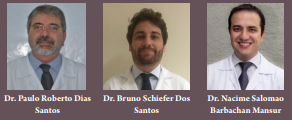Regeneration of the Patellar Tendon with Radial Pressure Waves in a Sharp Injury: A Case Report
Case Report | Vol 4 | Issue 1 | January-June 2024 | page: 20-23 | A A Flores Salinas, G C Reyes Cordero, L B García Rodriguez, L C Villa Olivares
DOI: https://doi.org/10.13107/jrs.2024.v04.i01.127
Author: A A Flores Salinas [1], G C Reyes Cordero [2], L B García Rodriguez [3], L C Villa Olivares [4]
[1] Department of Rehabilitation Medicine, Medical Director of Physis Clinics, Chihuahua, Mexico,
[2] Department of Rheumatology, Hospital Ángeles, Chihuahua, Mexico,
[3] Department of Orthopedics and Traumatology, Hospital Central Universitario, Chihuahua, Mexico,
[4] Department of Radiology, Civil Pensions of the State of Chihuahua, Mexico.
Address of Correspondence
Dr. A A Flores Salinas,
Department of Rehabilitation Medicine, Medical Director of Physis Clinics, Chihuahua, Mexico.
Email- drazaelflores@hotmail.com
Abstract
Patellar tendon ruptures are rare injuries and are more commonly associated with predisposing factors and previous surgical procedures than with direct trauma. Acute partial-thickness tears are usually treated with immobilization and rehabilitation. The literature recommends surgical management of partial ruptures of the patellar tendon after 6 months of failure of conservative treatments and in acute cases with a compromise >50–55% of the tendon. Radial pressure wave therapy is a safe, non-invasive technique with scientific support in tissue regeneration; it is found as one of the therapeutic alternatives for the management of tendinopathy and partial ruptures of the patellar tendon. The present case report shows the effectiveness of radial pressure wave therapy in a shear injury of the patellar tendon, with a compromise of at least 70%. We have not found similar cases previously reported in the literature, highlighting its relevance.
Keywords: Patellar tendon, Radial pressure waves, Patellar tendon rupture, Cutting injury
References:
1. Matava MJ. Patellar tendon ruptures. J Am Acad Orthop Surg 1996;4:287-96.
2. Pires R, Prado J, Hara R, Ferreira E, Schiavo L, Giordano V, et al. Epidemiological study on tendon ruptures of the knee extensor mechanism at a level 1 hospital. Rev Bras Ortop 2015;47:719-23.
3. Stinner D, Orr JD, Hsu JR. Fluoroquinolone-associated bilateral patellar tendon rupture: A case report and review of the literature. Mil Med 2010;175:457-9. Pages 457–459, https://doi.org/10.7205/MILMED-D-09-00142
4. van der Linden PD, Sturkenboom MC, Herings RM, Leufkens HG, Stricker BH. Fluoroquinolones and risk of Achilles tendon disorders: case-control study. BMJ. 2002 Jun 1;324(7349):1306-7. doi: 10.1136/bmj.324.7349.1306. PMID: 12039823; PMCID: PMC113766.
5. Yang F, Wang GD, Huang R, Ma H, Zhao XW. Ligament augmentation reconstruction system artificial ligaments in patellar tendon reconstruction – a chronic patellar tendon rupture after multiple operations: A case report. World J Clin Cases. 2020 Feb 26;8(4):831-837. doi: 10.12998/wjcc.v8.i4.831. PMID: 32149068; PMCID: PMC7052563.
6. Brinkman JC, Reeson E, Chhabra A. Acute Patellar Tendon Ruptures: An Update on Management. J Am Acad Orthop Surg Glob Res Rev. 2024 Apr 3;8(4):e24.00060. doi: 10.5435/JAAOSGlobal-D-24-00060. PMID: 38569093; PMCID: PMC10994452.
7. Zhang J, Keenan C, Wang JH. The effects of dexamethasone on human patellar tendon stem cells: implications for dexamethasone treatment of tendon injury. J Orthop Res. 2013 Jan;31(1):105-10. doi: 10.1002/jor.22193. Epub 2012 Aug 8. PMID: 22886634; PMCID: PMC3498577.
8. Pritchard CH, Berney S. Patellar tendon rupture in systemic lupus erythematosus. J Rheumatol 1989;16:786-8.
9. Golman M, Wright ML, Wong TT, Lynch TS, Ahmad CS, Thomopoulos S, Popkin CA. Rethinking Patellar Tendinopathy and Partial Patellar Tendon Tears: A Novel Classification System. Am J Sports Med. 2020 Feb;48(2):359-369. doi: 10.1177/0363546519894333. Epub 2020 Jan 8. PMID: 31913662.
10. Swamy GN, Nanjayan SK, Yallappa S, Bishnoi A, Pickering SA. Is ultrasound diagnosis reliable in acute extensor tendon injuries of the knee? Acta Orthop Belg 2012;78:764-70.
11. Karlsson J, Kälebo P, Goksör LA, Thomée R, Swärd L. Partial rupture of the patellar ligament. Am J Sports Med 1992;20:390-5.
12. Moya D, Loske AM, Hobrough P, Moya C. History of Shock Waves and Radial Pressure Waves From Newton to Our Times. Journal of Regenerative Science. Jan-Jun 2023; 3(1): 09-14. DOI:10.13107/jrs.2023.v03.i01.70
13. Moya D, Ramón S, Schaden W, Wang CJ, Guiloff L, Cheng JH. The Role of Extracorporeal Shockwave Treatment in Musculoskeletal Disorders. J Bone Joint Surg Am. 2018 Feb 7;100(3):251-263. doi: 10.2106/JBJS.17.00661. PMID: 29406349.
14. Ramon S, Español A, Yebra M, Morillas JM, Unzurrunzaga R, Freitag K, et al. Current evidence in shockwave treatment. SETOC (Spanish Society of Shockwave Treatment) recommendations Rehabilitación (Madr) 2021;55:291-300. DOI: 10.1016/j.rh.2021.02.002
15. Cleveland RO, Chitnis PV, McClure SR. Acoustic field of a ballistic shock wave therapy device. Ultrasound Med Biol. 2007 Aug;33(8):1327-35. doi: 10.1016/j.ultrasmedbio.2007.02.014. Epub 2007 Apr 27. PMID: 17467154.
16. Loske AM. Medical and Biomedical Applications of Shock Waves. Cham, Switzerland: Springer International; 2017. p. 19-42.
17. Wang CJ. Extracorporeal shockwave therapy in musculoskeletal disorders. J Orthop Surg Res. 2012 Mar 20;7:11. doi: 10.1186/1749-799X-7-11. PMID: 22433113; PMCID: PMC3342893.
18. Moreno GM. Definition and classification of obesity. R Méd Clín Las Condes 2012;23:124-8.
19. Wright JG, Einhorn TA, Heckman JD. Grades of recommendation. J Bone Joint Surg Am. 2005 Sep;87(9):1909-10. doi: 10.2106/JBJS.8709.edit. PMID: 16140803.
20. van der Worp H, Zwerver J, Hamstra M, van den Akker-Scheek I, Diercks RL. No difference in effectiveness between focused and radial shockwave therapy for treating patellar tendinopathy: a randomized controlled trial. Knee Surg Sports Traumatol Arthrosc. 2014 Sep;22(9):2026-32. doi: 10.1007/s00167-013-2522-z. Epub 2013 May 12. PMID: 23666379.
21. Haupt G. Use of extracorporeal shock waves in the treatment of pseudarthrosis, tendinopathy and other orthopedic diseases. J Urol. 1997 Jul;158(1):4-11. doi: 10.1097/00005392-199707000-00003. PMID: 9186313.
22. Thijs KM, Zwerver J, Backx FJ, Steeneken V, Rayer S, Groenenboom P, Moen MH. Effectiveness of Shockwave Treatment Combined With Eccentric Training for Patellar Tendinopathy: A Double-Blinded Randomized Study. Clin J Sport Med. 2017 Mar;27(2):89-96. doi: 10.1097/JSM.0000000000000332. PMID: 27347857.

| How to Cite this article: Salinas AAF, Cordero GCR, Rodriguez LBG, and Olivares LCV. Regeneration of the Patellar Tendon with Radial Pressure Waves in a Sharp Injury: A Case Report. Journal of Regenerative Science 2024;January-June;4(1):20-23. |




